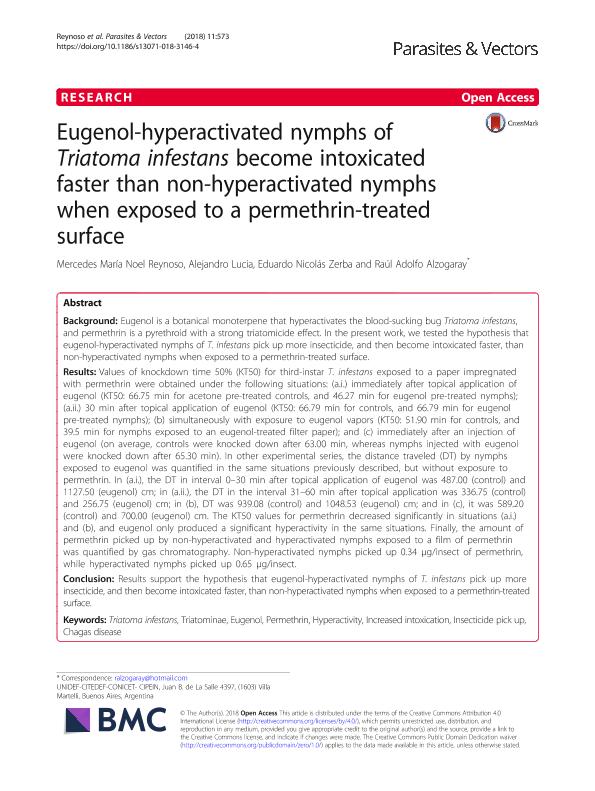Artículo
Eugenol-hyperactivated nymphs of Triatoma infestans become intoxicated faster than non-hyperactivated nymphs when exposed to a permethrin-treated surface
Fecha de publicación:
11/2018
Editorial:
BioMed Central
Revista:
Parasites and Vectors
ISSN:
1756-3305
Idioma:
Inglés
Tipo de recurso:
Artículo publicado
Clasificación temática:
Resumen
Background: Eugenol is a botanical monoterpene that hyperactivates the blood-sucking bug Triatoma infestans, and permethrin is a pyrethroid with a strong triatomicide effect. In the present work, we tested the hypothesis that eugenol-hyperactivated nymphs of T. infestans pick up more insecticide, and then become intoxicated faster, than non-hyperactivated nymphs when exposed to a permethrin-treated surface. Results: Values of knockdown time 50% (KT50) for third-instar T. infestans exposed to a paper impregnated with permethrin were obtained under the following situations: (a.i.) immediately after topical application of eugenol (KT50: 66.75 min for acetone pre-treated controls, and 46.27 min for eugenol pre-treated nymphs); (a.ii.) 30 min after topical application of eugenol (KT50: 66.79 min for controls, and 66.79 min for eugenol pre-treated nymphs); (b) simultaneously with exposure to eugenol vapors (KT50: 51.90 min for controls, and 39.5 min for nymphs exposed to an eugenol-treated filter paper); and (c) immediately after an injection of eugenol (on average, controls were knocked down after 63.00 min, whereas nymphs injected with eugenol were knocked down after 65.30 min). In other experimental series, the distance traveled (DT) by nymphs exposed to eugenol was quantified in the same situations previously described, but without exposure to permethrin. In (a.i.), the DT in interval 0-30 min after topical application of eugenol was 487.00 (control) and 1127.50 (eugenol) cm; in (a.ii.), the DT in the interval 31-60 min after topical application was 336.75 (control) and 256.75 (eugenol) cm; in (b), DT was 939.08 (control) and 1048.53 (eugenol) cm; and in (c), it was 589.20 (control) and 700.00 (eugenol) cm. The KT50 values for permethrin decreased significantly in situations (a.i.) and (b), and eugenol only produced a significant hyperactivity in the same situations. Finally, the amount of permethrin picked up by non-hyperactivated and hyperactivated nymphs exposed to a film of permethrin was quantified by gas chromatography. Non-hyperactivated nymphs picked up 0.34 μg/insect of permethrin, while hyperactivated nymphs picked up 0.65 μg/insect. Conclusion: Results support the hypothesis that eugenol-hyperactivated nymphs of T. infestans pick up more insecticide, and then become intoxicated faster, than non-hyperactivated nymphs when exposed to a permethrin-treated surface.
Archivos asociados
Licencia
Identificadores
Colecciones
Articulos(INEDES)
Articulos de INSTITUTO DE ECOLOGIA Y DESARROLLO SUSTENTABLE
Articulos de INSTITUTO DE ECOLOGIA Y DESARROLLO SUSTENTABLE
Articulos(UNIDEF)
Articulos de UNIDAD DE INVESTIGACION Y DESARROLLO ESTRATEGICOS PARA LA DEFENSA
Articulos de UNIDAD DE INVESTIGACION Y DESARROLLO ESTRATEGICOS PARA LA DEFENSA
Citación
Reynoso, Mercedes María Noel; Lucia, Alejandro; Zerba, Eduardo Nicolás; Alzogaray, Raúl Adolfo; Eugenol-hyperactivated nymphs of Triatoma infestans become intoxicated faster than non-hyperactivated nymphs when exposed to a permethrin-treated surface; BioMed Central; Parasites and Vectors; 11; 1; 11-2018; 573-581
Compartir
Altmétricas




